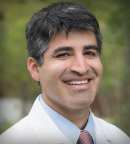
Syed A. Abutalib, MD

Alex Francisco Herrera, MD
Classical Hodgkin lymphoma (HL) is a highly curable disease, but up to 25% of patients will develop relapsed or refractory classical HL. Although most patients achieve complete response following front-line therapy, key unmet clinical needs include reducing the relapse rate, decreasing acute and long-term treatment-related morbidity, enhancing quality of life, and improving poor outcomes in patients older than age 60.
The incorporation of novel therapies, including checkpoint inhibitors and antibody-drug conjugates, into the front-line setting, sequential approaches, and further individualized treatment intensity may address some of these unmet needs. Attempts to decrease the use of consolidative radiation therapy, particularly in younger patients with classical HL, may also be of benefit.
To complement The ASCO Post’s extensive coverage of the 2023 American Society of Hematology (ASH) Annual Meeting & Exposition, here are two important abstracts selected from the meeting proceedings focusing on the treatment of advanced-stage classical HL in the older and pediatric populations. For full details of the study abstracts, visit www.hematology.org/meetings/annual-meeting/abstracts.
SWOG S1826: Older Population
ABSTRACT 181: Nivolumab plus doxorubicin, vinblastine, and dacarbazine (N-AVD; n = 48) is better tolerated and improves progression-free survival compared with brentuximab vedotin (Bv) plus AVD (Bv-AVD; n = 49) in older patients (aged ≥ 60) with advanced-stage classical HL.1
Background: Survival rates in patients with classical HL aged 60 or older are lower than those in younger adults. The difference is the result of comorbidities, impaired performance status, decreased chemotherapy tolerance, and increased treatment-related toxicity and mortality. The front-line regimen Bv-AVD can be challenging to administer in older patients because of toxicities, particularly infection and neuropathy. The PD-1 pathway is central to the pathogenesis of classical HL; PD-1 blockade has been found to be safe and effective as part of front-line therapy for classical HL.
Methods: Response and disease progression were assessed by investigators using the 2014 Lugano classification. The primary endpoint was progression-free survival. Prespecified patients could receive radiation therapy to residual lesions found on a positron-emission tomography scan at the end of treatment.
Results: In this subset analysis, with a median follow-up of 12.1 months, progression-free survival was superior with N-AVD (hazard ratio [HR] = 0.35; 95% confidence interval [CI] = 0.12–1.02; stratified one-sided log rank P = .022); 1-year progression-free survival was 93% (95% CI = 79%–98%) with N-AVD and 64% (95% CI = 45%–77%) with Bv-AVD.
“Longer follow-up is needed to better define the roles of N-AVD and Bv-AVD for advanced-stage classical HL in the pediatric population.”— SYED ALI ABUTALIB, MD, AND ALEX FRANCISCO HERRERA, MD
Tweet this quote
The incidence of febrile neutropenia, sepsis, and infections was lower for patients who received the nivolumab regimen vs the brentuximab vedotin regimen. Peripheral neuropathy occurred much less frequently with N-AVD than Bv-AVD. The following adverse events occurred less often with N-AVD vs Bv-AVD: nausea, diarrhea, anorexia, and weight loss. Hypothyroidism (15% vs 0%) and rash (16% vs 2%, no grade ≥ 3) were more common with N-AVD than Bv-AVD; the rates of other immune-related toxicities were similar between the arms. More patients discontinued Bv-AVD (n = 19) than N-AVD (n = 7), primarily because of toxicity.
Clinical Implications: N-AVD improved progression-free survival and was better tolerated than Bv-AVD in patients aged ≥ 60 with advanced-stage classical HL. Fewer deaths occurred in those treated with N-AVD (n = 2) than in those given Bv-AVD (n = 7). N-AVD is poised to become a standard of care for older patients with advanced-stage classical HL.
SWOG S1826: Pediatric Population
ABSTRACT 610: Progression-free survival and toxicity with N-AVD (n = 120) compared with Bv-AVD (n = 117) in pediatric patients (aged ≥ 12–17) with advanced-stage classical HL.2
Background: Approaches to therapy in pediatric and adult classical HL have differed historically. Brentuximab vedotin is efficacious in pediatric patients with high-risk classical HL when combined with chemotherapy and response-adapted, involved-site radiation therapy.3 Inhibition of the PD-1 pathway, central to the pathogenesis of classical HL, is safe and effective in children with relapsed classical HL, but it has not been evaluated in the front-line setting.
Methods: Eligible patients were randomly assigned 1:1 to receive either six cycles of N-AVD or Bv-AVD. The primary endpoint was progression-free survival.
Results: In the pediatric cohort, 6 progression-free survival events were observed after N-AVD compared with 12 events after Bv-AVD. At a median follow-up of 12.1 months, the progression-free survival was compared between arms (HR = 0.48, 95% CI = 0.18–1.28, stratified one-sided log rank P = .067) in the -pediatric -cohort; 1-year progression-free survival rates were 94% with N-AVD and 88% with Bv-AVD.
The rate of grade ≥ 3 hematologic adverse events was 45% after N-AVD compared with 41% after Bv-AVD. Overall rates of immune-related adverse events were low. The incidence of hypothyroidism or hyperthyroidism was higher after N-AVD (2% with nivolumab vs 0% with brentuximab vedotin). Rash was more common with Bv-AVD. Although sensory peripheral neuropathy was more frequent after Bv-AVD (sensory: 18% with nivolumab vs 29% with brentuximab vedotin; motor: 8% with nivolumab vs 5% with brentuximab vedotin), just 1% was higher than grade 3. Discontinuation of nivolumab vs brentuximab vedotin therapy occurred in 8.3% vs 2.6% of pediatric patients, respectively, compared with 7.9% vs 21.1% of adults. There have been no deaths reported in this age group.
Clinical Implications: With 12.1 months of median follow-up, the progression-free survival benefit observed with N-AVD in pediatric patients mirrors that observed in the overall study. The use of radiation therapy was substantially lower, and the cumulative doxorubicin dose was higher than in historical pediatric classical HL trials. Longer follow-up is needed to better define the roles of N-AVD and Bv-AVD for advanced-stage classical HL in the pediatric population.
DISCLOSURE: Dr. Herrera reported financial relationships with Bristol Myers Squibb, Genentech, Merck, Seattle Genetics, Kite Pharma, Gilead Sciences, AstraZeneca, Karyopharm Therapeutics, ADC Therapeutics, Takeda, Tubulis, Regeneron, Genmab, Pfizer, Caribou Biosciences, Adicet Bio, AbbVie, and Allogene Therapeutics. Dr. Abutalib reported a financial relationship with AstraZeneca.
REFERENCES
1. Rutherford SC, Li H, Herrera AF, et al: Nivolumab-AVD is better tolerated and improves progression-free survival compared to Bv-AVD in older patients (aged ≥ 60 years) with advanced stage Hodgkin lymphoma enrolled on SWOG S1826. 2023 American Society of Hematology Annual Meeting & Exposition. Abstract 181. Presented December 9, 2023.
2. Castellino SM, Li H, Herrera AF, et al: Progression-free survival and toxicity with nivolumab-AVD compared to brentuximab vedotin-AVD in pediatric advanced stage classic Hodgkin lymphoma: Results of SWOG S1826. 2023 American Society of Hematology Annual Meeting & Exposition. Abstract 610. Presented December 10, 2023.
3. Castellino SM, Pei Q, Parsons SK, et al: Brentuximab vedotin with chemotherapy in pediatric high-risk Hodgkin’s lymphoma. N Engl J Med 387:1649-1660, 2022.
Dr. Abutalib is Director of the Malignant Hematology and Transplantation & Cellular Therapy Programs at the Advocate/Aurora St. Luke’s Medical Center, Milwaukee, and Associate Professor at Rosalind Franklin University of Medicine and Science, Chicago. Dr. Herrera is Chief of the Division of Lymphoma at City of Hope Medical Center, Duarte, California.

